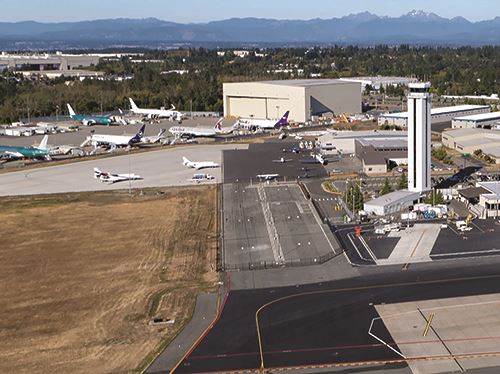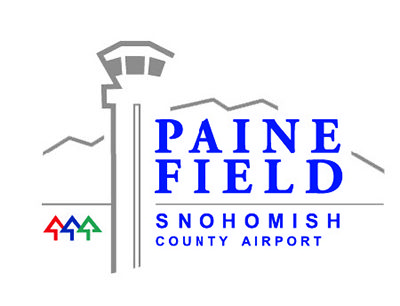Paine Field (PAE), just north of Seattle, saved an estimated quarter of a million dollars and two months of time on recent ramp repairs by suspending commercial passenger flights and closing the terminal to complete the project while traffic was already slow due to COVID-19. The strategy also spared its airlines and passengers the service disruptions such work typically causes.
Paine Field (PAE), just north of Seattle, saved an estimated quarter of a million dollars and two months of time on recent ramp repairs by suspending commercial passenger flights and closing the terminal to complete the project while traffic was already slow due to COVID-19. The strategy also spared its airlines and passengers the service disruptions such work typically causes.
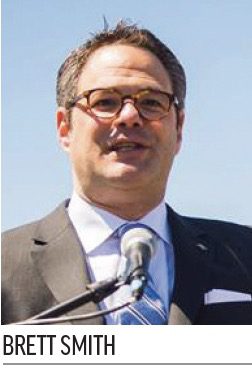 Propeller Airports, the private company that owns and operates the terminal through a long-term lease agreement with Snohomish County, was already planning to renovate the airside pavement. The coronavirus epidemic simply changed its strategy and accelerated the timeline for the $1.5 million project.
Propeller Airports, the private company that owns and operates the terminal through a long-term lease agreement with Snohomish County, was already planning to renovate the airside pavement. The coronavirus epidemic simply changed its strategy and accelerated the timeline for the $1.5 million project.
Brett Smith, chief executive officer of Propeller Airports, notes that shortly after the terminal opened for commercial service in 2019, divots began appearing in aircraft parking areas. “Everyone believed the pavement would be able to tolerate the aircraft movements that we anticipated, partly because Boeing 747s used to be parked there,” Smith explains. “But it turns out that the weight distribution of a 747 is over a much greater span than the E175s that utilize our airport.”
|
Project: Ramp Replacement Location: Paine Field (Everett, WA)
Terminal Owner/Operator: Project Scope: 3 aircraft parking pads, each 35,000 sq. ft. Total Cost: $1.5 million Construction: 57 days Completed: July 2020
Related Closure: 71 days Engineering: Hanson Professional Services Concrete Contractor: Salinas Construction Of Note: Fast-tracking project during COVID-inspired terminal closure saved an estimated $250,000 & prevented associated service disruptions for airlines & passengers Future Work: Runway reconstruction & taxiway rehabilitation; master plan study by Landrum & Brown |
Propeller and the airlines deemed the divots to be a safety issue, and Propeller installed steel plates at the parking positions as a short-term fix. The longer-term solution was to replace the asphalt parking pads near the gates with concrete. “Before COVID, we were going to do it over a four-month period of time,” says Smith. “However, because of COVID and the drastic drop of passenger traffic, we felt there was an opportunity to get it all done at once without disrupting our passengers or airlines.”
After securing FAA permission to suspend commercial passenger flights for 71 days (from May 22 to July 31), Propeller put its replacement plan into action.
Quick Turn Around
Hanson Professional Services, the firm that redesigned the ramp after the terminal opened in 2019, had originally planned to structure the more recent project through a series of carefully coordinated gate closures/openings and off-hour construction. When officials decided to temporarily close the terminal, everything changed.
“We had been working with the airport on a plan to pull the asphalt out and replace it with concrete,” explains Blake Swafford, senior project manager with Hanson. “When the airport opted to close the terminal and move forward with the work, we took the plans we were working on and redid them very quickly to prepare for the shutdown.”
The project scope included three asphalt parking positions, each measuring about 35,000 square feet. Two are permanent positions serviced by jet bridges (Gates 1 and 2); the third is used for ground loading during busy times and overnight aircraft parking.
Crews from Salinas Construction spent six days pulling up the existing asphalt. Then they laid 6 to 7 inches of aggregate onto the cleared surface and installed standard rebar to prepare for a 14-inch layer of concrete.
“They were the perfect partner and the perfect contractor for the job,” Swafford says, noting that Salinas designed a concrete mix with high-strength and early-curing products specifically for PAE’s ramp.
The job was completed in 57 days, and all three pads can now hold Airbus A321s, Boeing 737-900s and other similarly sized aircraft.
Strategy Validated
Before plans changed to replace the parking pads during a COVID-inspired closure, some personnel at Propeller were dreading the ramp project. “I knew it would be massively disruptive to passengers and airlines,” Smith relates. “We would have gotten through it, of course, but there probably would have been some nasty tweets.”
But completing the project without any traffic on the tarmac helped the reconstruction process run smoothly and saved an estimated $250,000 on $1.5 million of work, he explains.
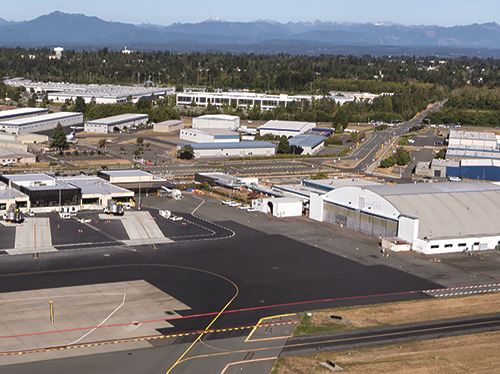
Moreover, the new concrete is considered to be a 30-year fix. “We spent a lot of money to do it right,” Smith says, adding that some important benefits can’t be measured strictly in money. “We’re talking about passenger convenience and no flight delays.”
 Hanson’s Swafford was also pleased with how the change in execution strategy affected the project. “Gate positions are typically being used all day long, and quite often, this kind of work is done at night and one gate at a time,” he comments. “We just happened to have COVID-19, which impacted traffic volumes to a point where the terminal was able to shut down for a period of time to do the work. Being shut down provided the opportunity to do the work all at once, which was a time savings, a cost savings and ultimately resulted in a better-quality end product for the airport.”
Hanson’s Swafford was also pleased with how the change in execution strategy affected the project. “Gate positions are typically being used all day long, and quite often, this kind of work is done at night and one gate at a time,” he comments. “We just happened to have COVID-19, which impacted traffic volumes to a point where the terminal was able to shut down for a period of time to do the work. Being shut down provided the opportunity to do the work all at once, which was a time savings, a cost savings and ultimately resulted in a better-quality end product for the airport.”
Smith reports there have been no problems with the new parking surfaces since commercial passenger flights have resumed. “We have a safer environment, and we can use our gates without any encumbrance,” he elaborates. “And the pilots who use our airport really love it. Our goal is to exceed what normally can be done and never compromise on safety.”
Happy Anniversary
Prior to the coronavirus pandemic, PAE had been offering commercial service for about one year. In fact, it broke the 1 million passengers mark during its 50th week of operation. With United Airlines and Alaska Airlines serving a total of 12 cities, about 3,000 passengers were going through the terminal on an average day.
Like other airports, PAE experienced a precipitous decline in passenger volume this spring when COVID-19 took center stage in the U.S., but Smith reports that traffic began to slowly tick up after it resumed full operations in August. With new COVID-19 precautious in place, only ticketed passengers are allowed into the terminal, and all passengers and employees must wear face coverings. A thermal camera mounted on the terminal ceiling scans for people who have temperatures greater than 100.4 F. As of late September, the cameras had not detected any high-temperature individuals.
“It’s not that I don’t want extra people in the terminal, but it’s just not necessary right now,” Smith says. “It’s all about making sure that the airport staff, passengers and airline employees are all safe.”
The terminal’s small size makes it easy to keep clean, he adds. “We don’t have as much surface space as a large airport.”
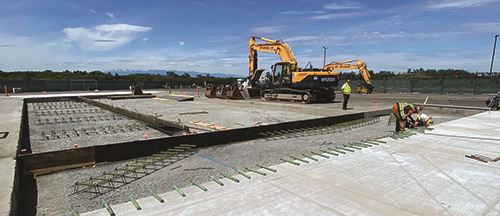
Smith predicts that smaller airports like PAE will become even more attractive to passengers in the coming months. “People are starting to recognize that they can get to the same destination by going through a smaller airport that they can get in and out of quickly,” he explains.
Despite dramatic changes in the industry, Smith reports that some things never change. “Our goal remains the same: to make sure we exceed our customers’ expectations. And we are doing that,” he reports. “We’re back open, and people are excited.”
More Improvements Coming
 Airport Director Arif Ghouse notes that PAE has several other capital improvement projects in the works, including the reconstruction of its main runway and rehabilitation of adjacent taxiways.
Airport Director Arif Ghouse notes that PAE has several other capital improvement projects in the works, including the reconstruction of its main runway and rehabilitation of adjacent taxiways.
In addition, Landrum & Brown will begin developing a master plan later this year. The study is expected to take two to four years to complete and cost $2.5 million.
“This master plan will be a blueprint for how we want to develop the airport for the next five, 10, 15 and 20 years,” says Ghouse. “It will tell us how we will do all those projects.”

